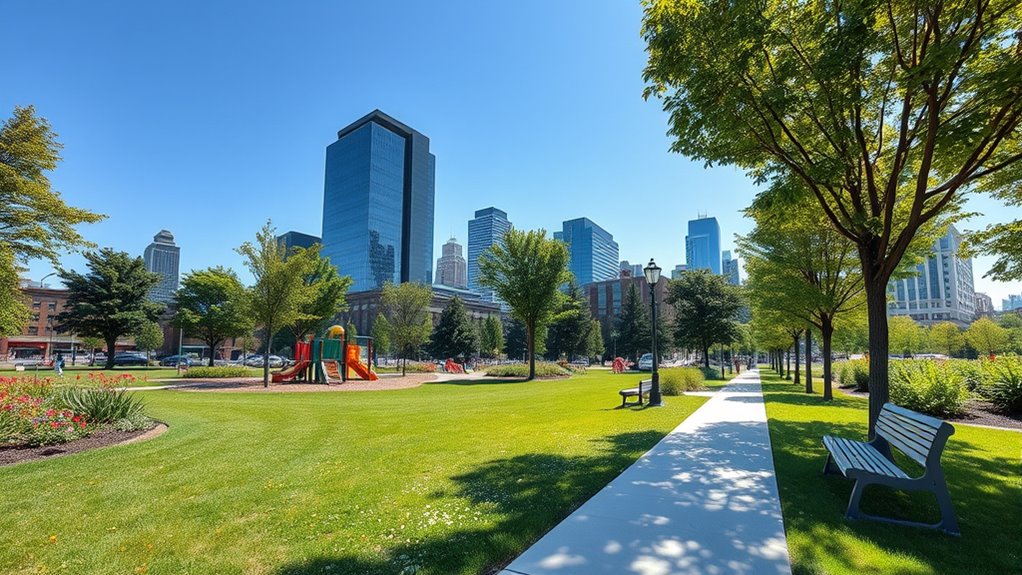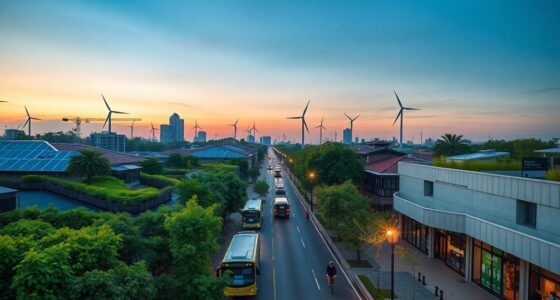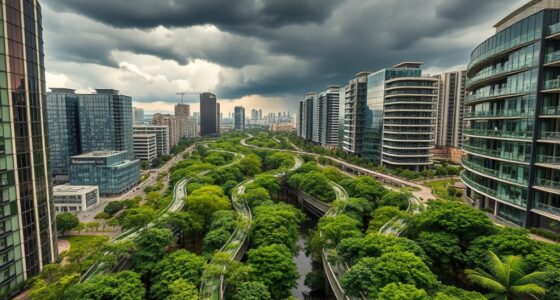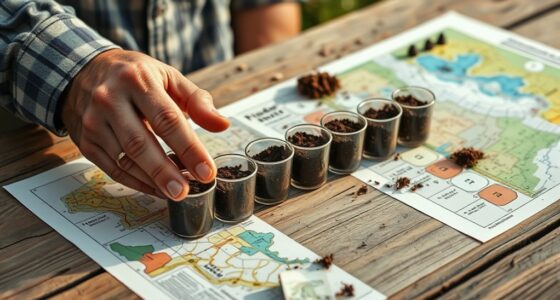Transforming brownfields into parks shows how communities can turn overlooked industrial sites into vibrant public spaces. These projects highlight resilience, sustainable growth, and community involvement, breathing new life into abandoned areas. By repurposing old factories and warehouses, neighborhoods become more attractive, safe, and lively. Many cities worldwide have successfully accomplished this, inspiring others to see potential where decay once existed. To find out more about these inspiring transformations and their impact, keep exploring these innovative stories.
Key Takeaways
- Community engagement ensures brownfield redevelopments reflect local needs and foster a sense of ownership.
- Transforming industrial sites into parks revitalizes neighborhoods, promoting social cohesion and economic activity.
- Sustainable design, integrating natural elements like wind and wave energy, enhances ecological restoration in urban parks.
- Successful global examples demonstrate how collaborative efforts turn neglected spaces into vibrant, resilient urban landscapes.
- Repurposing old factories preserves historical elements while creating inclusive green spaces that symbolize urban resilience.
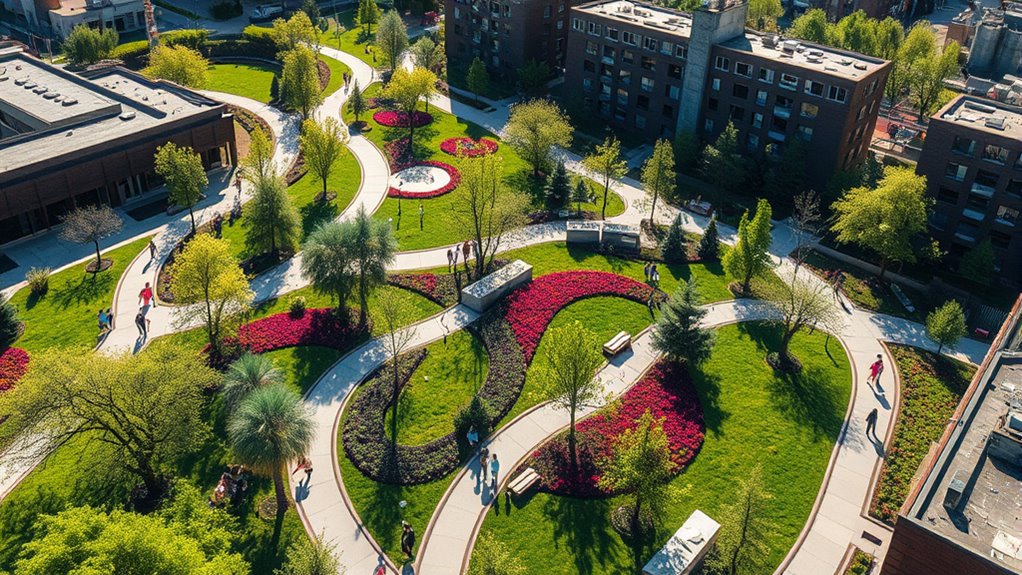
Urban transformation stories showcase how cities evolve from overlooked spaces into vibrant communities, reflecting innovation and resilience. One powerful way this happens is through turning brownfields—abandoned industrial sites—into lively parks and public spaces. When you look at these areas, it’s easy to see how they hold untapped potential. With strategic planning and community involvement, these once-neglected sites become assets that breathe new life into neighborhoods. The process begins with recognizing the value of industrial revival, which means repurposing old factories, warehouses, and other industrial remnants rather than demolishing them. This approach preserves a piece of the city’s history while creating opportunities for recreation, social gathering, and ecological restoration.
Community engagement plays an essential role in this transformation. When residents, local organizations, and city officials collaborate, they can identify what the community truly needs from these spaces. You might be surprised how much input can shape a project, ensuring it reflects local culture, priorities, and aspirations. It’s more than just planting trees or building playgrounds; it’s about fostering a sense of ownership and pride among residents. As community members get involved in planning, design, and maintenance, the project becomes more sustainable and meaningful. This collective effort often leads to increased safety, economic activity, and social cohesion in the area.
Community involvement ensures sustainable, meaningful projects that reflect local culture, foster pride, and promote safety and social cohesion.
Transforming brownfields into parks also sparks an industrial revival, as it demonstrates how old infrastructure can be repurposed instead of left to decay. This shift not only revitalizes specific sites but also signals a broader commitment to sustainable urban development. It encourages investment, attracts visitors, and can even inspire nearby property owners to improve their own spaces. When communities rally around these projects, they send a message that their neighborhoods matter and that they’re capable of shaping their future. Additionally, incorporating elements like wave and wind can help create sustainable landscapes that respect natural coastal processes and reduce environmental impact.
Ultimately, these stories prove that turning neglected industrial sites into parks isn’t just about beautification—it’s about reclaiming space, fostering community cohesion, and showcasing resilience. You see this in cities worldwide, where former factories have been transformed into lush green areas that serve as the heart of neighborhoods. These projects remind us that with vision, collaboration, and a willingness to reinvent, overlooked spaces can become symbols of urban vitality and hope. The journey from brownfield to park exemplifies the power of collective effort and innovative thinking to reshape cities into more inclusive, vibrant places for everyone.
Frequently Asked Questions
How Do Cities Fund Brownfield Redevelopment Projects?
You can fund brownfield redevelopment projects through public-private partnerships that pool resources and expertise. Tax incentive programs also encourage investment by offering financial benefits to developers. Local governments often provide grants or low-interest loans, making projects more feasible. By combining these strategies, you’ll find it easier to transform contaminated sites into vibrant community spaces and economic hubs, fostering urban renewal and long-term growth.
What Are Common Challenges Faced During Urban Transformation?
When tackling urban transformation, you often face challenges like land use conflicts and strict zoning regulations. These issues can slow down projects, limit design options, or create disagreements among stakeholders. managing these hurdles requires careful planning and collaboration. You need to work with local authorities, community members, and developers to find solutions that balance growth with existing land use policies, ensuring successful and sustainable urban renewal.
How Do Community Members Influence Park Redesigns?
Like a compass guiding a ship, community members steer park redesigns through active engagement. Your involvement matters because public input shapes the final design, ensuring it meets local needs and preferences. When you participate in public meetings or share ideas, you influence decisions and help create spaces that truly reflect the community’s spirit. Your voice makes parks more inclusive, vibrant, and functional for everyone who uses them.
What Environmental Benefits Result From These Transformations?
When parks are redesigned, you help improve environmental benefits through actions like soil remediation, which cleans contaminated soil, and by planting trees that boost air quality. These transformations reduce pollution, lower urban heat, and create healthier surroundings. Your involvement in these projects promotes cleaner air and safer soil, making the community more livable. Ultimately, your participation helps turn neglected spaces into vibrant, eco-friendly parks that benefit everyone.
How Long Does a Typical Brownfield-To-Park Project Take?
Imagine planting a seed that takes time to grow. A typical brownfield-to-park project often spans 1 to 3 years, depending on site assessment complexities and community engagement. You start by evaluating the land, engaging local residents, and planning the transformation. Patience is key, as careful remediation and planning guarantee a vibrant park. With dedication, you turn a neglected site into a thriving community space, much like nurturing a healthy garden.
Conclusion
As you’ve seen, transforming brownfields into vibrant parks shows that every challenge holds a chance for renewal. With creativity and community effort, abandoned spaces can become thriving green havens. Remember, a journey of a thousand miles begins with a single step. So, don’t be afraid to start small—your city’s next inspiring transformation could be just around the corner. Embrace the change, and watch your community flourish where obstacles once stood.
